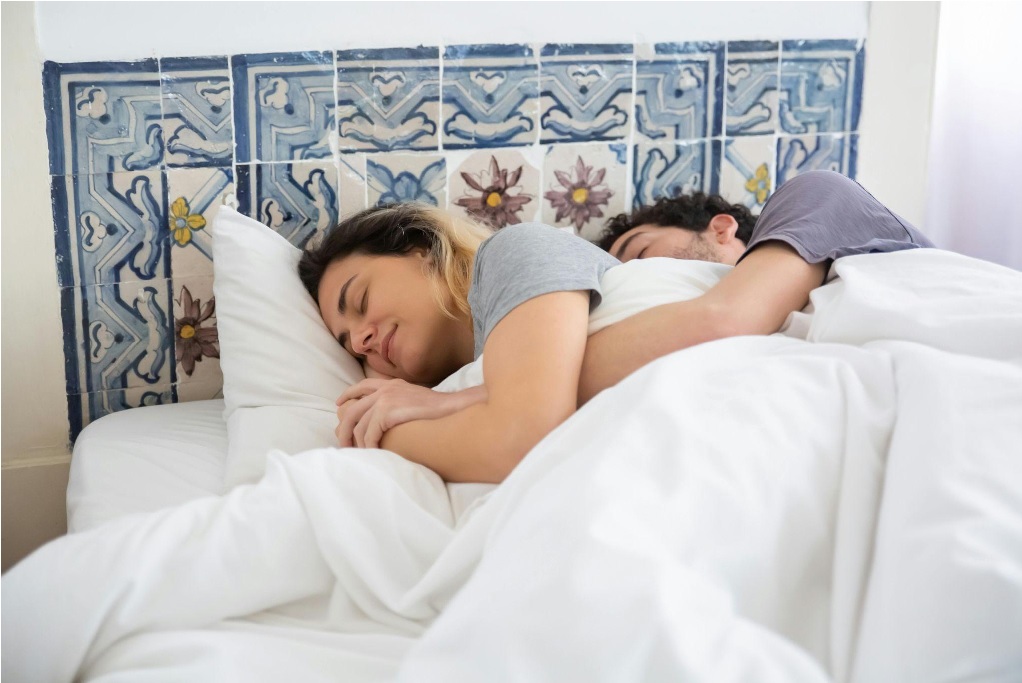How to Address Common Sleep Challenges Faced by Couples
Jul 24th 2024
Most couples share the same bed, as it’s a comforting and intimate experience. However, it can also bring about a variety of sleep challenges that can disrupt the rest of both partners. From snoring to differing sleep schedules, many couples often face hurdles that can lead to sleepless nights. Fortunately, there are plenty of ways to tackle these issues and enjoy a peaceful night’s sleep together. Read on below:

What Are the Most Common Challenges Faced by Couples?
First things first, let’s understand some of the most common sleep challenges that couples can face:
Snoring and Sleep Apnea
When it comes to sleep disturbances in couples, snoring has to be one of the most, if not the most, notorious culprits. It isn’t just a minor annoyance – snoring can significantly impact the sleep quality of both partners. In some cases, snoring can be a sign of sleep apnea, a serious condition where breathing repeatedly stops and starts during sleep.
Different Sleep Schedules
Couples can have different sleep schedules due to work, personal preferences, or lifestyle habits. One partner might be an early bird who loves waking up at the crack of dawn, while the other is a night owl who thrives in the wee hours of the night. This mismatch can lead to conflicts and disrupted sleep.
Temperature Preferences
Differing temperature preferences can be another source of conflict and stress for both partners. One might prefer a cool and crisp sleeping environment, while the other may like it to be warm and cozy instead. Finding the right balance can be tricky, but it's essential for a good night's sleep.
Tossing and Turning
If one partner is a restless sleeper who tosses and turns all night, it can disturb the other's sleep. This can be especially problematic if the movement causes the bed to shake or the covers to be pulled off.
Bed and Bedding Preferences
Couples might also have different preferences when it comes to mattress firmness, or the type of bedding used in their bed. One might enjoy a firm mattress, while the other might want something softer to lie down in. The same goes for pillows and blankets.
Effective Solutions for Better Sleep
Now that we know what we’re dealing with, let’s explore some practical solutions on how to address the common sleep issues outlined above:
Addressing Snoring and Sleep Apnea
If snoring is the issue (or one of the major ones), there are several strategies that you and your partner can consider. You can encourage the snoring partner to sleep on their side, as this position can help reduce snoring. There are also anti-snoring devices, such as nasal strips or mouthpieces, that can help. For more severe cases, it's essential to consult a doctor. Sleep apnea is a serious condition that may require medical intervention, such as a CPAP machine.
Aligning Sleep Schedules
Adjusting your sleep schedules to match can be challenging, but it isn’t impossible. Try to find a compromise that allows both partners to get adequate rest. This might involve gradually shifting bedtimes or wake-up times until you find a middle ground. To help block out disturbances when one partner goes to bed or wakes up earlier, you might also want to try using earplugs, or using a white noise machine.
Managing Temperature Differences
When it comes to different temperature preferences, the Scandinavian sleep method on a king bed can work wonders. It’s simple: all it involves is still sleeping in the same bed, but under different duvets, comforters, blankets, or quilts.
Our down comforters here at The Down Comforter Store are the best solution: you can try out the Scandinavian sleep method on a king bed for yourself by buying two different comforters here on our website according to your temperature and weight preferences. Our offerings are both chemical- and allergen-free, and made out of humanely harvested, cruelty-free down and feathers.
Best of all, our comforters are Oeko Tex, Downafresh Greenline, and Nomite certified, making them the best choice for the Scandinavian sleep method on a king bed. Once you’ve tried it out, you’ll find that you may not want to go back to sleeping under the same comforter again!
Minimizing Disturbances from Movement
If tossing and turning is the problem, then you might want to consider investing in a mattress that minimizes motion transfer. Memory foam mattresses, for example, are known for their ability to absorb movement. Using separate blankets, as in the Scandinavian sleep method, can also reduce disturbances, as it allows each partner to move independently without disturbing the other while they’re sleeping.
Finding the Right Bed and Bedding
Finding a compromise on bed and bedding preferences can make a significant difference. Test different mattresses together and find one that suits both partners' comfort levels. Opt for pillows that offer support and comfort tailored to individual needs. When it comes to bedding, consider using separate blankets or a larger duvet that provides enough coverage for both.
Enhancing Sleep Hygiene Together
Improving sleep hygiene can have a positive impact on both partners' sleep quality. Here are some tips to enhance your sleep environment:
Reducing Screen Time Before Bed
The blue light emitted by phones, tablets, and computers can interfere with your body’s natural sleep-wake cycle. That’s why limiting screen time before bed is critical for good sleep hygiene. Encourage each other to switch your devices off at least an hour before bedtime; instead, engage in more calming activities such as reading a book, meditating, or having a light conversation about each other’s day.
Keeping the Bedroom Dark and Quiet
Create an optimal sleep environment by keeping the bedroom dark and quiet. Use blackout curtains to block out any external light and consider using earplugs or a white noise machine to drown out any disruptive sounds. A sleep mask can also be helpful if one partner is sensitive to light.
Maintaining a Consistent Sleep Schedule
Consistency is key when it comes to sleep. Try to go to bed and wake up at the same time every day, even on weekends. This helps regulate your body's internal clock and improves overall sleep quality. Supporting each other in sticking to a regular schedule can make a big difference.

Addressing sleep challenges as a couple requires patience, understanding, and a willingness to compromise. By identifying the common issues, exploring practical solutions, and enhancing your sleep hygiene, you can create a harmonious sleep environment that benefits both partners.



